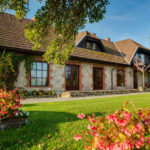From 1747 to 1755, the manor belonged to Alexey Bestuzhev-Ryumin (Бестужев-Рюмин, 1693–1766). In 1755 it was purchased by Johann Gottlieb von Wolff. At first, the manor was called Wolff Manor (Wolfsruh).
In the nineteenth century, the manor’s central building complex was expanded with new buildings. The first serious reconstruction works were undertaken by Count Joseph von Koskull when he began living at Kārļumuiža. As can be seen on an 1834 map of the manor, the central complex of buildings was joined around this time by new stables, cattle sheds, a tavern, a gardener’s house and a water mill. Slightly further away, a crypt for the landlords was built. In the second half of the 19th century, development of the complex continued: both farm buildings and housing for the manor’s workers and servants were built.
In 1777 the manor was bought by Karl Eberhard von Sievers, and the name of the manor was changed to Kārļumuiža (Karl Manor; Gute Karlsruh). The Sievers family did not just rebuild their main living quarters in Cēsis; in the 1780s, they formed a Baroque-style central building complex in Kārļumuiža suitable for their needs at the time.
On the initiative of Karl’s brother Peter Christian von Sievers, they installed paths, lanes and romantic resting places to create a charming landscape park. The beautiful surroundings with a striking terrain, sandstone cliffs on the banks of the river, wooded knolls and flower-rich lowlands, formed an expressive background for the planning of the manor buildings while at the same time highlighting special conditions. The desire and ability of the former owner to unite practical needs with aesthetic pleasure allowed Kārļumuiža to become a well considered, beautiful and tasteful set of buildings skillfully place in the natural landscape. The manor was a source of pleasure not only for its inhabitants but also for travellers and tourists from the near vicinity and further afield. The landscape park, formed at the end of the 18th century, was a testament to the best tastes and appreciation of the beauty of the era. The gorgeous surroundings with the magnificent Amata riverbank became a beloved place to visit for travellers at the end of the 18th century through the 19th century. Interest was so great that, in 1796, Vidzeme district administrator Wilhelm Friedrich Freiherr von Ungern-Sternberg recommended setting up a comfortable house where the many travellers could spend the night and purchase food. The former owner of the manor, court advisor Karl Eberhard von Sievers, also considered building a hotel.

